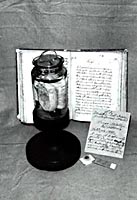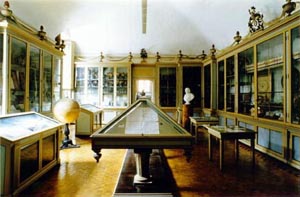In the Porta room, all the display material, collected in three sets of shelves on the quadrangle-side walls, is specimens realised and studied by Luigi Porta for his work On Pathalogical Changes in Arteries, Caused by Ligatures and Torsion. In this study, he demonstrates and explains how collateral circles are formed, especially in experiments on animals. There are numerous specimens, admirable for their effectiveness as demonstration material, especially those obtained by linking dissection and injection techniques.
Alongside these, there are hand-written records of these and other exper iments, volumes of case histories and files on the most interesting anatomic preparations on display. In addition, there are ovarian cysts and other pathologies, unobtainable nowadays, many of which demonstrate how organs in an advanced pathological state can alter their shape, structure and anatomical relationship.
iments, volumes of case histories and files on the most interesting anatomic preparations on display. In addition, there are ovarian cysts and other pathologies, unobtainable nowadays, many of which demonstrate how organs in an advanced pathological state can alter their shape, structure and anatomical relationship.
From among the numerous specimens and pieces of apparatus on view we can mention the electric battery for thermo-galvanic dieresis of the prostate, invented in 1830 by Enrico Bottini for treating prostatic ischuria. Specimens of vessels and their ligatures are also to be seen, along with 800 pathology file cards dating back to about 1830, which can usefully be studied even nowadays.
The Museum possesses volumes of reports on experiments and case histories (about thirty of them), and those which Porta collected and had bound are all complete, though only a few are on public view.
The "apothecary's box" is specially noteworthy. It contains little bottles of oil, vinegar, vitriol, laudanum, nicotine, emollient ointments and other compounds. In the central display cabinet we find writings, documents and letters on Ugo Foscolo, Vincenzo Monti, and Gigli Berzolari whose school report is also there. One of the cabinets is devoted to Taramelli, the geologist, displaying some appreciations, photographs of geological excursions and a few medals.
In this room there is also Napoleon's decree, dated 23rd June 1800, giving instructions for the re-organisation of the University into three faculties: Philosophy, Medicine and Law.
 I
I iments, volumes of case histories and files on the most interesting anatomic preparations on display. In addition, there are ovarian cysts and other pathologies, unobtainable nowadays, many of which demonstrate how organs in an advanced pathological state can alter their shape, structure and anatomical relationship.
iments, volumes of case histories and files on the most interesting anatomic preparations on display. In addition, there are ovarian cysts and other pathologies, unobtainable nowadays, many of which demonstrate how organs in an advanced pathological state can alter their shape, structure and anatomical relationship.